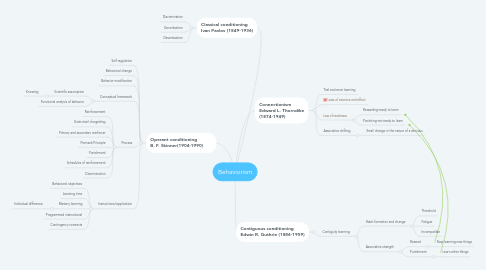
1. Classical conditioning Ivan Pavlov (1849-1936)
1.1. Discrimination
1.2. Generlization
1.3. Desentization
2. Operant conditioning B. F. Skinner(1904-1990)
2.1. Self-regulation
2.2. Behavioral change
2.3. Behavior modification
2.4. Conceptual framework
2.4.1. Scientific assumption
2.4.1.1. Knowing
2.4.2. Functional analysis of behavior
2.5. Process
2.5.1. Reinforcement
2.5.2. Extinction!=forgetting
2.5.3. Primary and secondary reinforcer
2.5.4. Premack Principle
2.5.5. Punishment
2.5.6. Schedules of reinforcement
2.5.7. Discrimination
2.6. Instructional application
2.6.1. Behavioral objectives
2.6.2. Learning time
2.6.3. Mastery learning
2.6.3.1. Individual difference
2.6.4. Programmed instructional
2.6.5. Contingency contracts
3. Connectionism Edward L. Thorndike (1874-1949)
3.1. Trial and error learning
3.2. Laws of exercise and effect
3.3. Law of readiness
3.3.1. Rewarding-ready to learn
3.3.2. Punishing-not ready to learn
3.4. Associative shifting
3.4.1. Small change in the nature of a stimulus
4. Contiguous conditioning Edwin R. Guthrie (1886-1959)
4.1. Contiguity learning
4.1.1. Habit formation and change
4.1.1.1. Threshold
4.1.1.2. Fatigue
4.1.1.3. Incompatible
4.1.2. Associative strength
4.1.2.1. Reward
4.1.2.1.1. Stop learning new things
4.1.2.2. Punishment
4.1.2.2.1. Learn other things

